MITS5501 Software Quality: Change Management and Testing Report
VerifiedAdded on 2022/10/13
|9
|2246
|131
Report
AI Summary
This report provides an in-depth analysis of software quality, change management, and testing, based on the provided academic paper. The report begins with an introduction to software quality, emphasizing its importance in software development and customer satisfaction. It then delves into the paper's content, focusing on the goal of improving software quality by managing impacting factors. The research methods, including the use of interpretivism and inductive approaches, along with data gathering and analysis techniques, are described. Key findings highlight the significance of identifying and mitigating risks to achieve software quality. Issues such as communication problems and the impact of third-party systems are discussed. The report concludes by summarizing the paper's methodology, which involves a Markov chain, and its recommendations for improving software quality through effective planning and processes. The report also emphasizes the relevance of the paper for students seeking to enhance their understanding of software quality and provides a comprehensive list of references.
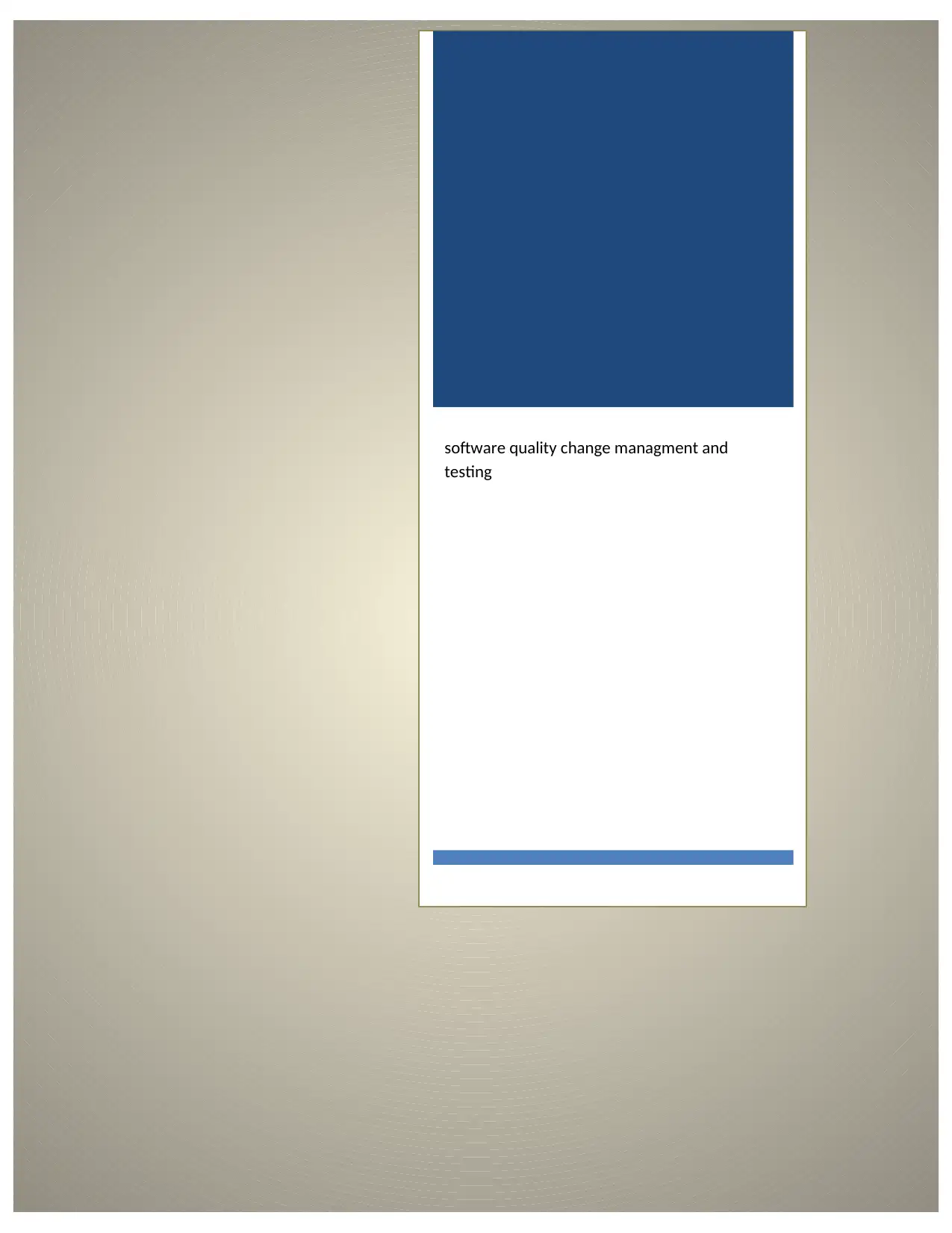
software quality change managment and
testing
testing
Paraphrase This Document
Need a fresh take? Get an instant paraphrase of this document with our AI Paraphraser
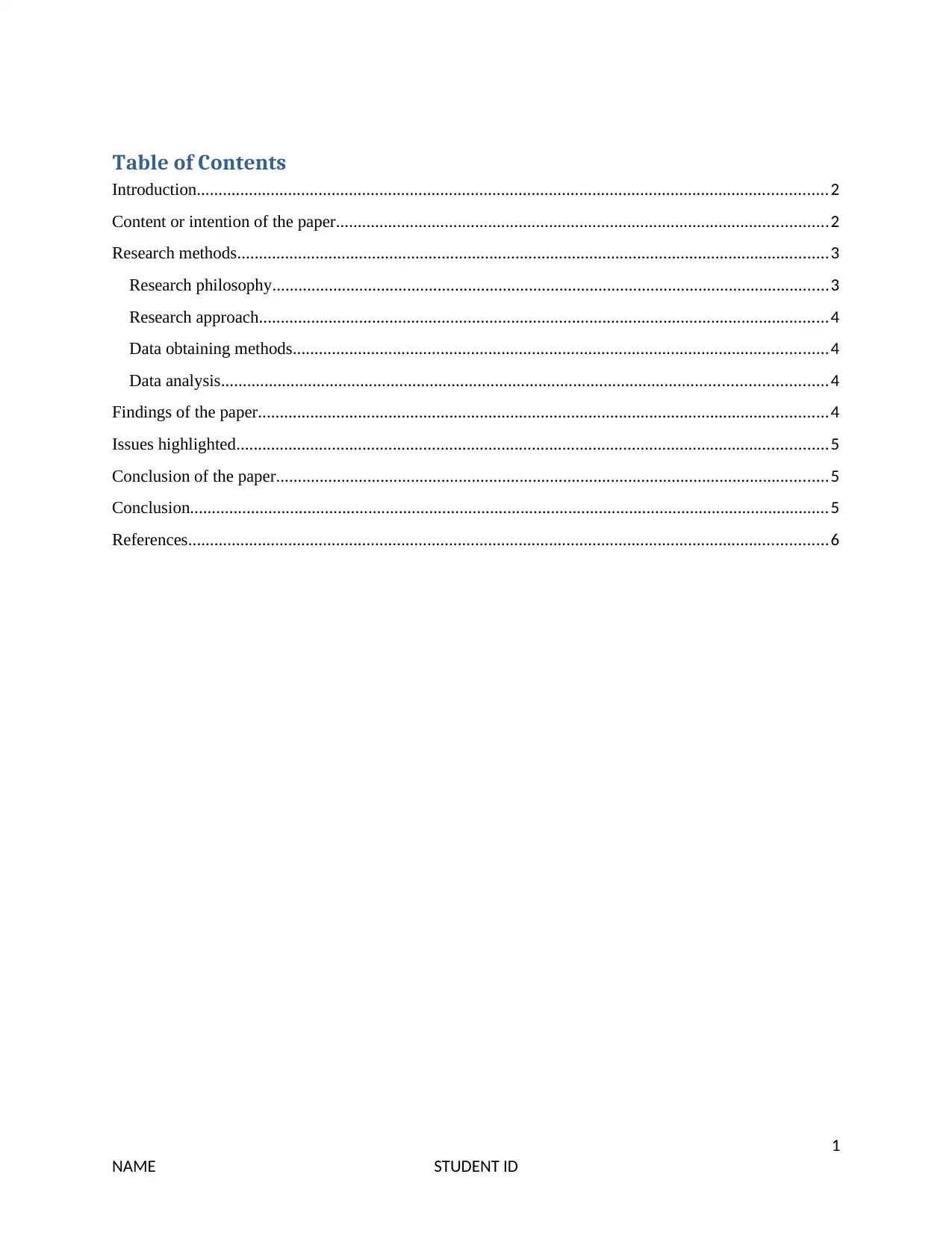
Table of Contents
Introduction.................................................................................................................................................2
Content or intention of the paper.................................................................................................................2
Research methods........................................................................................................................................3
Research philosophy................................................................................................................................3
Research approach...................................................................................................................................4
Data obtaining methods...........................................................................................................................4
Data analysis...........................................................................................................................................4
Findings of the paper...................................................................................................................................4
Issues highlighted........................................................................................................................................5
Conclusion of the paper...............................................................................................................................5
Conclusion...................................................................................................................................................5
References...................................................................................................................................................6
1
NAME STUDENT ID
Introduction.................................................................................................................................................2
Content or intention of the paper.................................................................................................................2
Research methods........................................................................................................................................3
Research philosophy................................................................................................................................3
Research approach...................................................................................................................................4
Data obtaining methods...........................................................................................................................4
Data analysis...........................................................................................................................................4
Findings of the paper...................................................................................................................................4
Issues highlighted........................................................................................................................................5
Conclusion of the paper...............................................................................................................................5
Conclusion...................................................................................................................................................5
References...................................................................................................................................................6
1
NAME STUDENT ID
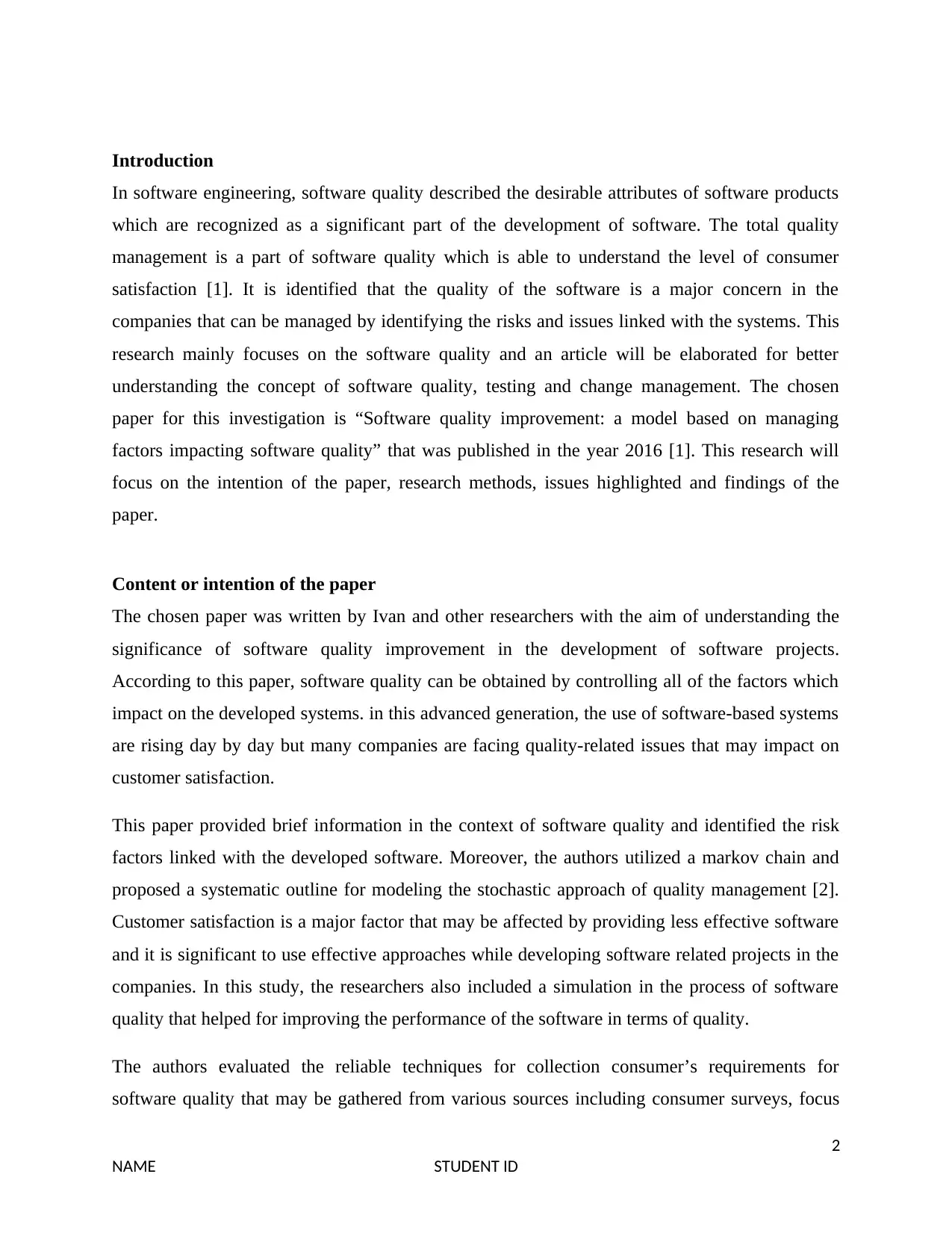
Introduction
In software engineering, software quality described the desirable attributes of software products
which are recognized as a significant part of the development of software. The total quality
management is a part of software quality which is able to understand the level of consumer
satisfaction [1]. It is identified that the quality of the software is a major concern in the
companies that can be managed by identifying the risks and issues linked with the systems. This
research mainly focuses on the software quality and an article will be elaborated for better
understanding the concept of software quality, testing and change management. The chosen
paper for this investigation is “Software quality improvement: a model based on managing
factors impacting software quality” that was published in the year 2016 [1]. This research will
focus on the intention of the paper, research methods, issues highlighted and findings of the
paper.
Content or intention of the paper
The chosen paper was written by Ivan and other researchers with the aim of understanding the
significance of software quality improvement in the development of software projects.
According to this paper, software quality can be obtained by controlling all of the factors which
impact on the developed systems. in this advanced generation, the use of software-based systems
are rising day by day but many companies are facing quality-related issues that may impact on
customer satisfaction.
This paper provided brief information in the context of software quality and identified the risk
factors linked with the developed software. Moreover, the authors utilized a markov chain and
proposed a systematic outline for modeling the stochastic approach of quality management [2].
Customer satisfaction is a major factor that may be affected by providing less effective software
and it is significant to use effective approaches while developing software related projects in the
companies. In this study, the researchers also included a simulation in the process of software
quality that helped for improving the performance of the software in terms of quality.
The authors evaluated the reliable techniques for collection consumer’s requirements for
software quality that may be gathered from various sources including consumer surveys, focus
2
NAME STUDENT ID
In software engineering, software quality described the desirable attributes of software products
which are recognized as a significant part of the development of software. The total quality
management is a part of software quality which is able to understand the level of consumer
satisfaction [1]. It is identified that the quality of the software is a major concern in the
companies that can be managed by identifying the risks and issues linked with the systems. This
research mainly focuses on the software quality and an article will be elaborated for better
understanding the concept of software quality, testing and change management. The chosen
paper for this investigation is “Software quality improvement: a model based on managing
factors impacting software quality” that was published in the year 2016 [1]. This research will
focus on the intention of the paper, research methods, issues highlighted and findings of the
paper.
Content or intention of the paper
The chosen paper was written by Ivan and other researchers with the aim of understanding the
significance of software quality improvement in the development of software projects.
According to this paper, software quality can be obtained by controlling all of the factors which
impact on the developed systems. in this advanced generation, the use of software-based systems
are rising day by day but many companies are facing quality-related issues that may impact on
customer satisfaction.
This paper provided brief information in the context of software quality and identified the risk
factors linked with the developed software. Moreover, the authors utilized a markov chain and
proposed a systematic outline for modeling the stochastic approach of quality management [2].
Customer satisfaction is a major factor that may be affected by providing less effective software
and it is significant to use effective approaches while developing software related projects in the
companies. In this study, the researchers also included a simulation in the process of software
quality that helped for improving the performance of the software in terms of quality.
The authors evaluated the reliable techniques for collection consumer’s requirements for
software quality that may be gathered from various sources including consumer surveys, focus
2
NAME STUDENT ID
⊘ This is a preview!⊘
Do you want full access?
Subscribe today to unlock all pages.

Trusted by 1+ million students worldwide
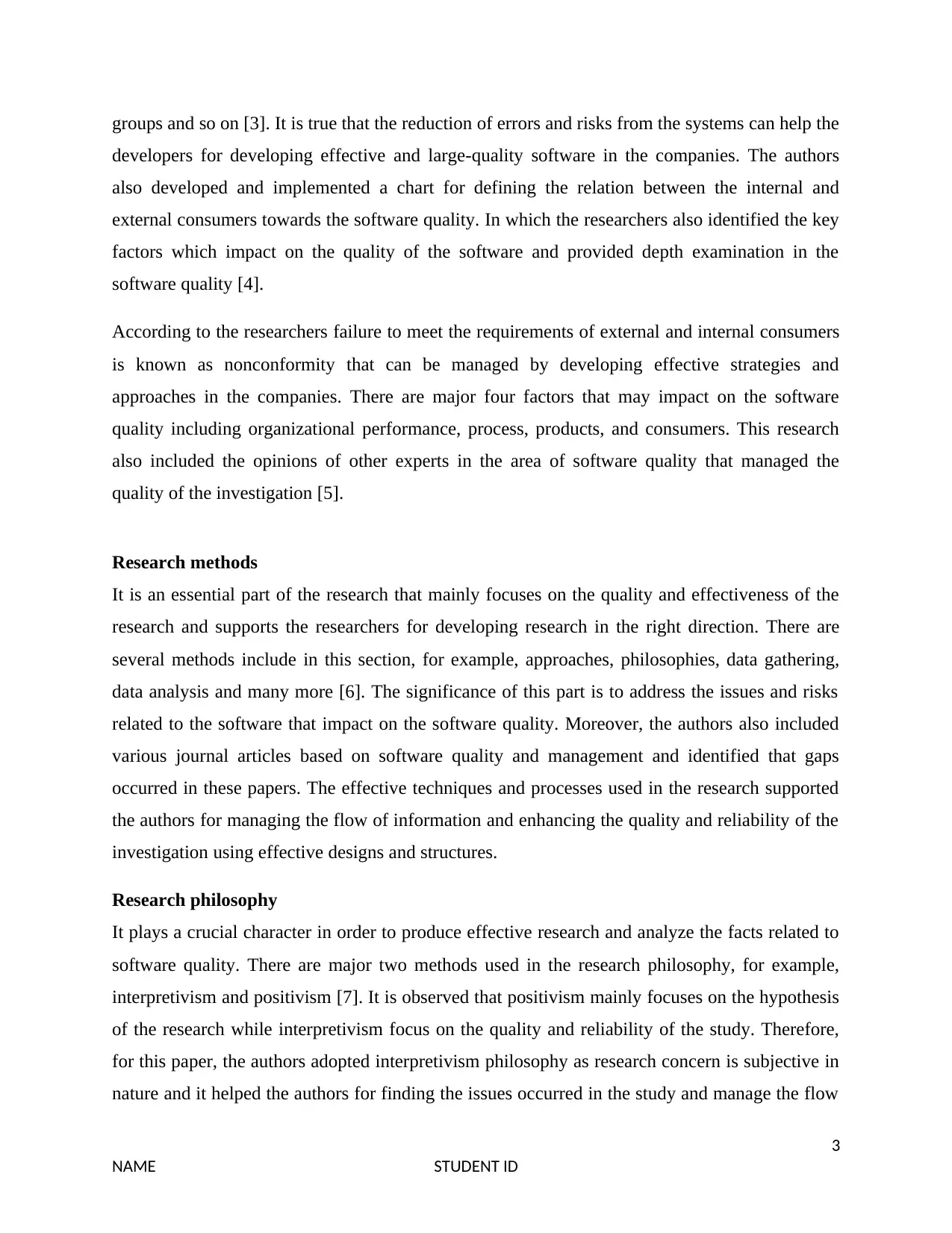
groups and so on [3]. It is true that the reduction of errors and risks from the systems can help the
developers for developing effective and large-quality software in the companies. The authors
also developed and implemented a chart for defining the relation between the internal and
external consumers towards the software quality. In which the researchers also identified the key
factors which impact on the quality of the software and provided depth examination in the
software quality [4].
According to the researchers failure to meet the requirements of external and internal consumers
is known as nonconformity that can be managed by developing effective strategies and
approaches in the companies. There are major four factors that may impact on the software
quality including organizational performance, process, products, and consumers. This research
also included the opinions of other experts in the area of software quality that managed the
quality of the investigation [5].
Research methods
It is an essential part of the research that mainly focuses on the quality and effectiveness of the
research and supports the researchers for developing research in the right direction. There are
several methods include in this section, for example, approaches, philosophies, data gathering,
data analysis and many more [6]. The significance of this part is to address the issues and risks
related to the software that impact on the software quality. Moreover, the authors also included
various journal articles based on software quality and management and identified that gaps
occurred in these papers. The effective techniques and processes used in the research supported
the authors for managing the flow of information and enhancing the quality and reliability of the
investigation using effective designs and structures.
Research philosophy
It plays a crucial character in order to produce effective research and analyze the facts related to
software quality. There are major two methods used in the research philosophy, for example,
interpretivism and positivism [7]. It is observed that positivism mainly focuses on the hypothesis
of the research while interpretivism focus on the quality and reliability of the study. Therefore,
for this paper, the authors adopted interpretivism philosophy as research concern is subjective in
nature and it helped the authors for finding the issues occurred in the study and manage the flow
3
NAME STUDENT ID
developers for developing effective and large-quality software in the companies. The authors
also developed and implemented a chart for defining the relation between the internal and
external consumers towards the software quality. In which the researchers also identified the key
factors which impact on the quality of the software and provided depth examination in the
software quality [4].
According to the researchers failure to meet the requirements of external and internal consumers
is known as nonconformity that can be managed by developing effective strategies and
approaches in the companies. There are major four factors that may impact on the software
quality including organizational performance, process, products, and consumers. This research
also included the opinions of other experts in the area of software quality that managed the
quality of the investigation [5].
Research methods
It is an essential part of the research that mainly focuses on the quality and effectiveness of the
research and supports the researchers for developing research in the right direction. There are
several methods include in this section, for example, approaches, philosophies, data gathering,
data analysis and many more [6]. The significance of this part is to address the issues and risks
related to the software that impact on the software quality. Moreover, the authors also included
various journal articles based on software quality and management and identified that gaps
occurred in these papers. The effective techniques and processes used in the research supported
the authors for managing the flow of information and enhancing the quality and reliability of the
investigation using effective designs and structures.
Research philosophy
It plays a crucial character in order to produce effective research and analyze the facts related to
software quality. There are major two methods used in the research philosophy, for example,
interpretivism and positivism [7]. It is observed that positivism mainly focuses on the hypothesis
of the research while interpretivism focus on the quality and reliability of the study. Therefore,
for this paper, the authors adopted interpretivism philosophy as research concern is subjective in
nature and it helped the authors for finding the issues occurred in the study and manage the flow
3
NAME STUDENT ID
Paraphrase This Document
Need a fresh take? Get an instant paraphrase of this document with our AI Paraphraser
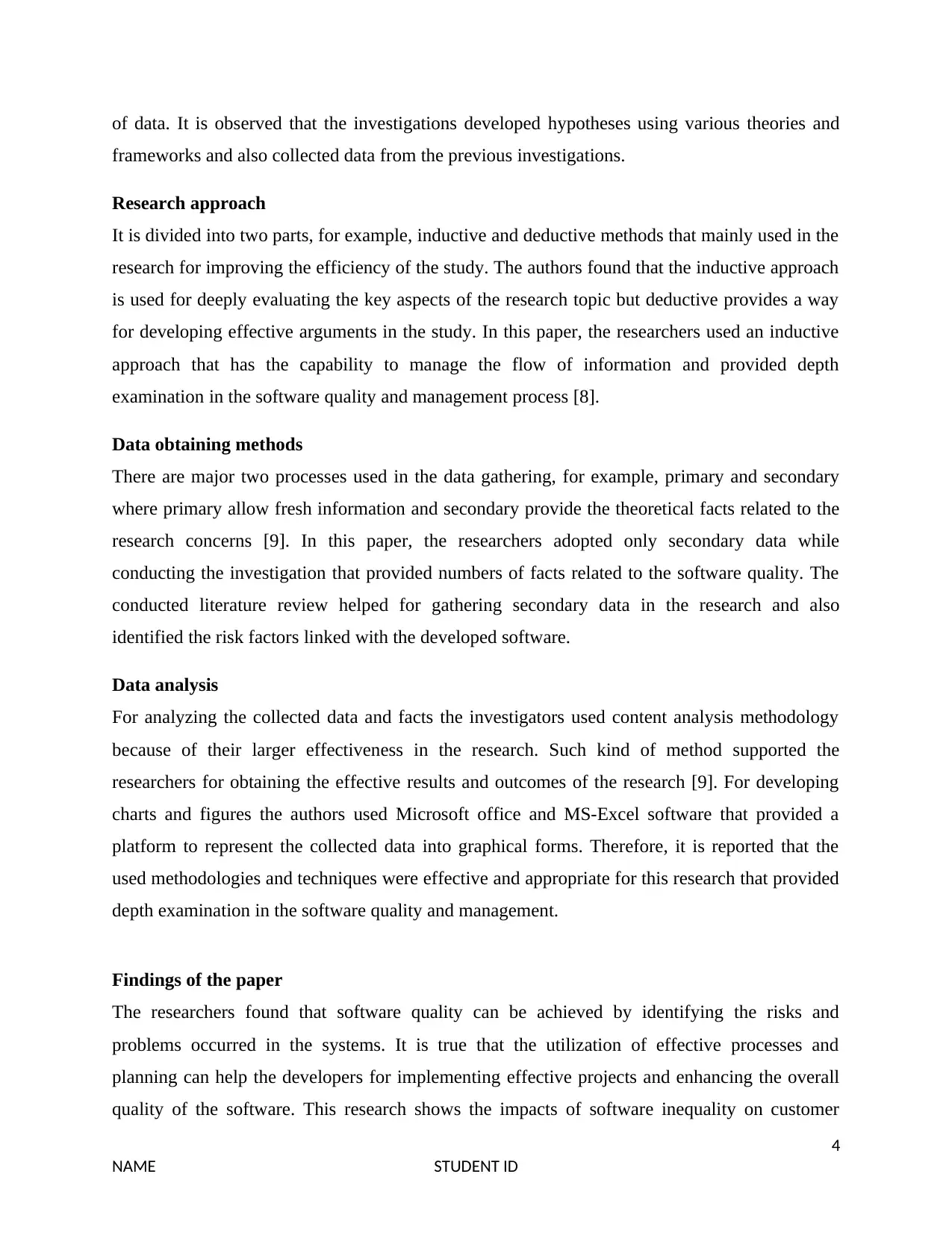
of data. It is observed that the investigations developed hypotheses using various theories and
frameworks and also collected data from the previous investigations.
Research approach
It is divided into two parts, for example, inductive and deductive methods that mainly used in the
research for improving the efficiency of the study. The authors found that the inductive approach
is used for deeply evaluating the key aspects of the research topic but deductive provides a way
for developing effective arguments in the study. In this paper, the researchers used an inductive
approach that has the capability to manage the flow of information and provided depth
examination in the software quality and management process [8].
Data obtaining methods
There are major two processes used in the data gathering, for example, primary and secondary
where primary allow fresh information and secondary provide the theoretical facts related to the
research concerns [9]. In this paper, the researchers adopted only secondary data while
conducting the investigation that provided numbers of facts related to the software quality. The
conducted literature review helped for gathering secondary data in the research and also
identified the risk factors linked with the developed software.
Data analysis
For analyzing the collected data and facts the investigators used content analysis methodology
because of their larger effectiveness in the research. Such kind of method supported the
researchers for obtaining the effective results and outcomes of the research [9]. For developing
charts and figures the authors used Microsoft office and MS-Excel software that provided a
platform to represent the collected data into graphical forms. Therefore, it is reported that the
used methodologies and techniques were effective and appropriate for this research that provided
depth examination in the software quality and management.
Findings of the paper
The researchers found that software quality can be achieved by identifying the risks and
problems occurred in the systems. It is true that the utilization of effective processes and
planning can help the developers for implementing effective projects and enhancing the overall
quality of the software. This research shows the impacts of software inequality on customer
4
NAME STUDENT ID
frameworks and also collected data from the previous investigations.
Research approach
It is divided into two parts, for example, inductive and deductive methods that mainly used in the
research for improving the efficiency of the study. The authors found that the inductive approach
is used for deeply evaluating the key aspects of the research topic but deductive provides a way
for developing effective arguments in the study. In this paper, the researchers used an inductive
approach that has the capability to manage the flow of information and provided depth
examination in the software quality and management process [8].
Data obtaining methods
There are major two processes used in the data gathering, for example, primary and secondary
where primary allow fresh information and secondary provide the theoretical facts related to the
research concerns [9]. In this paper, the researchers adopted only secondary data while
conducting the investigation that provided numbers of facts related to the software quality. The
conducted literature review helped for gathering secondary data in the research and also
identified the risk factors linked with the developed software.
Data analysis
For analyzing the collected data and facts the investigators used content analysis methodology
because of their larger effectiveness in the research. Such kind of method supported the
researchers for obtaining the effective results and outcomes of the research [9]. For developing
charts and figures the authors used Microsoft office and MS-Excel software that provided a
platform to represent the collected data into graphical forms. Therefore, it is reported that the
used methodologies and techniques were effective and appropriate for this research that provided
depth examination in the software quality and management.
Findings of the paper
The researchers found that software quality can be achieved by identifying the risks and
problems occurred in the systems. It is true that the utilization of effective processes and
planning can help the developers for implementing effective projects and enhancing the overall
quality of the software. This research shows the impacts of software inequality on customer
4
NAME STUDENT ID
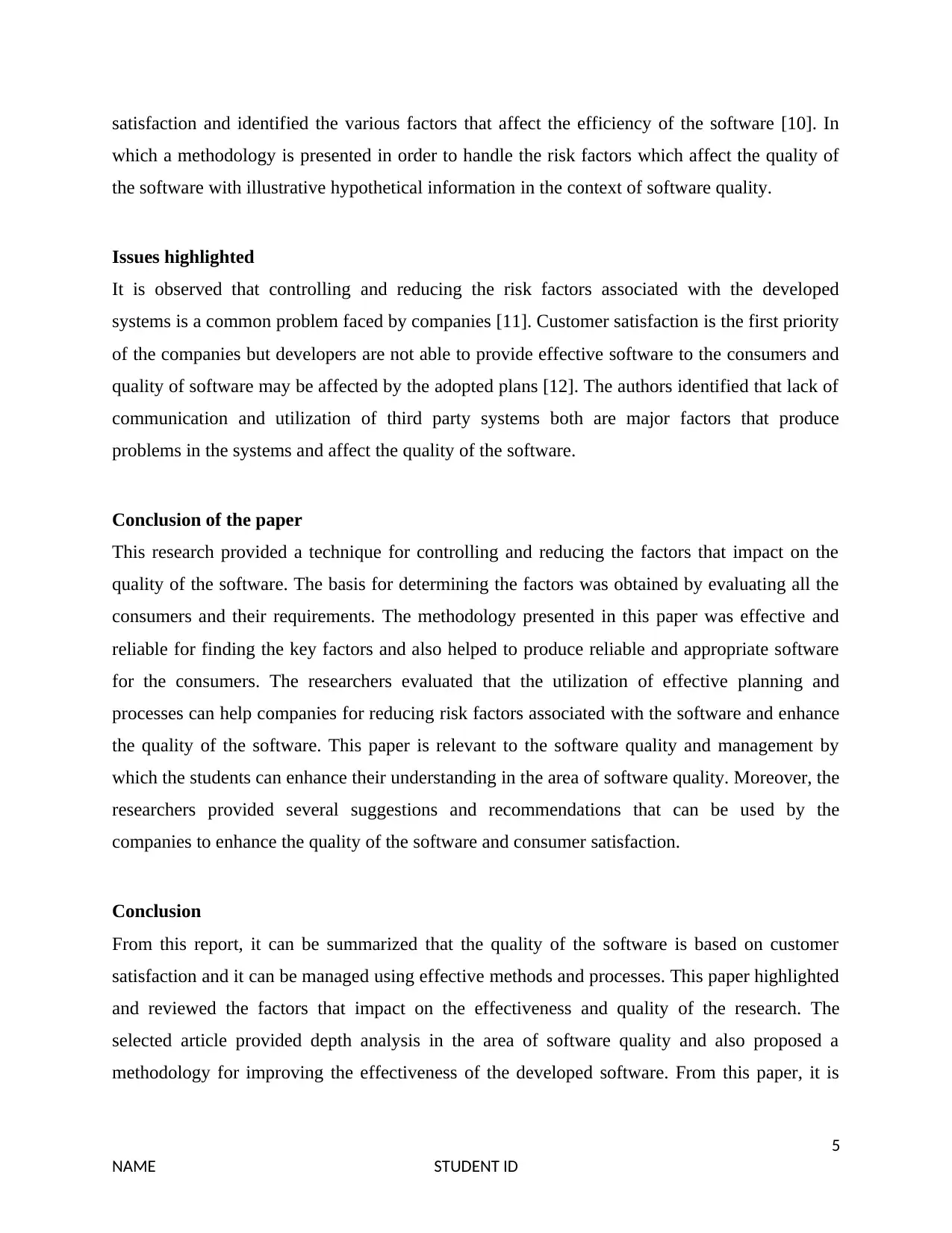
satisfaction and identified the various factors that affect the efficiency of the software [10]. In
which a methodology is presented in order to handle the risk factors which affect the quality of
the software with illustrative hypothetical information in the context of software quality.
Issues highlighted
It is observed that controlling and reducing the risk factors associated with the developed
systems is a common problem faced by companies [11]. Customer satisfaction is the first priority
of the companies but developers are not able to provide effective software to the consumers and
quality of software may be affected by the adopted plans [12]. The authors identified that lack of
communication and utilization of third party systems both are major factors that produce
problems in the systems and affect the quality of the software.
Conclusion of the paper
This research provided a technique for controlling and reducing the factors that impact on the
quality of the software. The basis for determining the factors was obtained by evaluating all the
consumers and their requirements. The methodology presented in this paper was effective and
reliable for finding the key factors and also helped to produce reliable and appropriate software
for the consumers. The researchers evaluated that the utilization of effective planning and
processes can help companies for reducing risk factors associated with the software and enhance
the quality of the software. This paper is relevant to the software quality and management by
which the students can enhance their understanding in the area of software quality. Moreover, the
researchers provided several suggestions and recommendations that can be used by the
companies to enhance the quality of the software and consumer satisfaction.
Conclusion
From this report, it can be summarized that the quality of the software is based on customer
satisfaction and it can be managed using effective methods and processes. This paper highlighted
and reviewed the factors that impact on the effectiveness and quality of the research. The
selected article provided depth analysis in the area of software quality and also proposed a
methodology for improving the effectiveness of the developed software. From this paper, it is
5
NAME STUDENT ID
which a methodology is presented in order to handle the risk factors which affect the quality of
the software with illustrative hypothetical information in the context of software quality.
Issues highlighted
It is observed that controlling and reducing the risk factors associated with the developed
systems is a common problem faced by companies [11]. Customer satisfaction is the first priority
of the companies but developers are not able to provide effective software to the consumers and
quality of software may be affected by the adopted plans [12]. The authors identified that lack of
communication and utilization of third party systems both are major factors that produce
problems in the systems and affect the quality of the software.
Conclusion of the paper
This research provided a technique for controlling and reducing the factors that impact on the
quality of the software. The basis for determining the factors was obtained by evaluating all the
consumers and their requirements. The methodology presented in this paper was effective and
reliable for finding the key factors and also helped to produce reliable and appropriate software
for the consumers. The researchers evaluated that the utilization of effective planning and
processes can help companies for reducing risk factors associated with the software and enhance
the quality of the software. This paper is relevant to the software quality and management by
which the students can enhance their understanding in the area of software quality. Moreover, the
researchers provided several suggestions and recommendations that can be used by the
companies to enhance the quality of the software and consumer satisfaction.
Conclusion
From this report, it can be summarized that the quality of the software is based on customer
satisfaction and it can be managed using effective methods and processes. This paper highlighted
and reviewed the factors that impact on the effectiveness and quality of the research. The
selected article provided depth analysis in the area of software quality and also proposed a
methodology for improving the effectiveness of the developed software. From this paper, it is
5
NAME STUDENT ID
⊘ This is a preview!⊘
Do you want full access?
Subscribe today to unlock all pages.

Trusted by 1+ million students worldwide
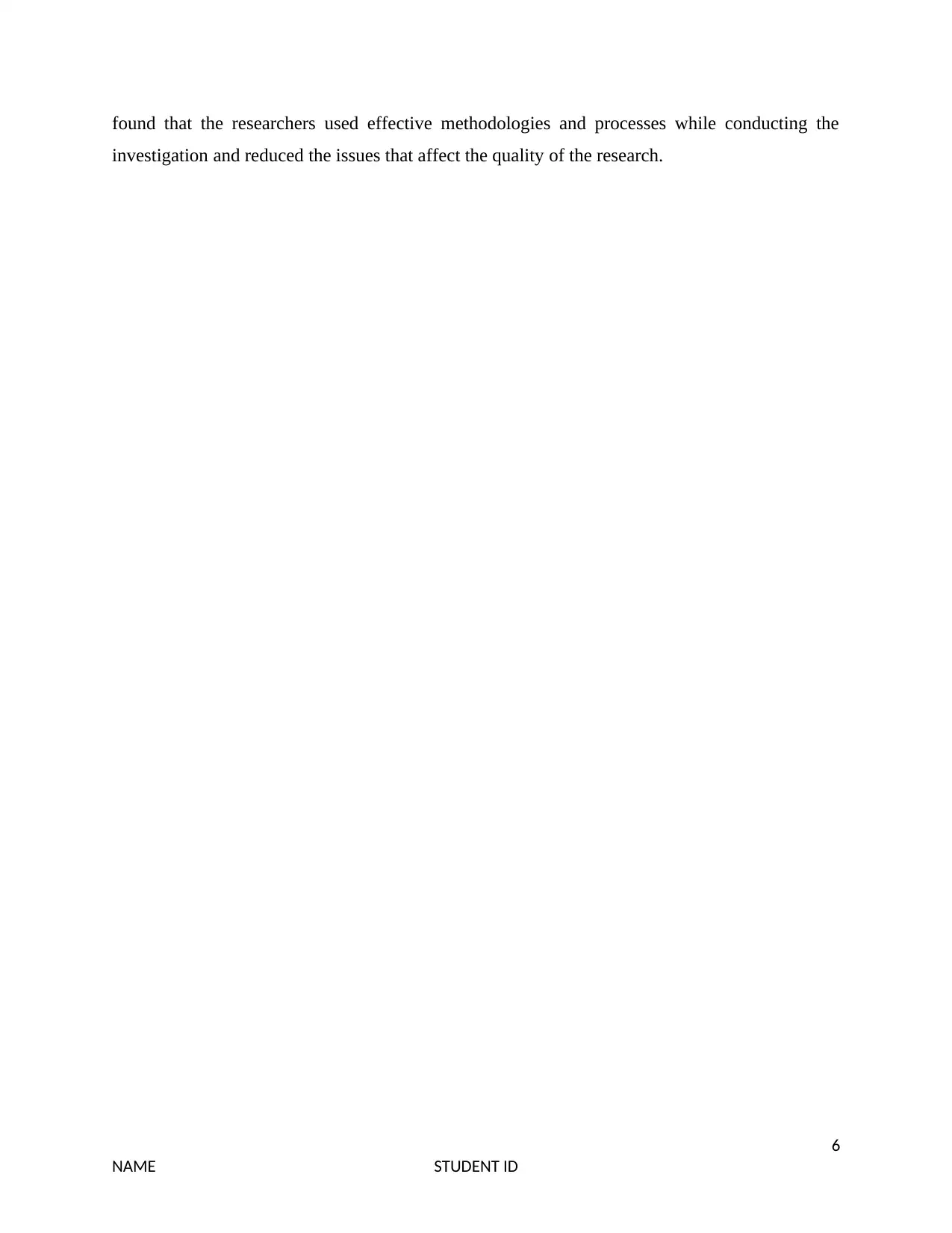
found that the researchers used effective methodologies and processes while conducting the
investigation and reduced the issues that affect the quality of the research.
6
NAME STUDENT ID
investigation and reduced the issues that affect the quality of the research.
6
NAME STUDENT ID
Paraphrase This Document
Need a fresh take? Get an instant paraphrase of this document with our AI Paraphraser
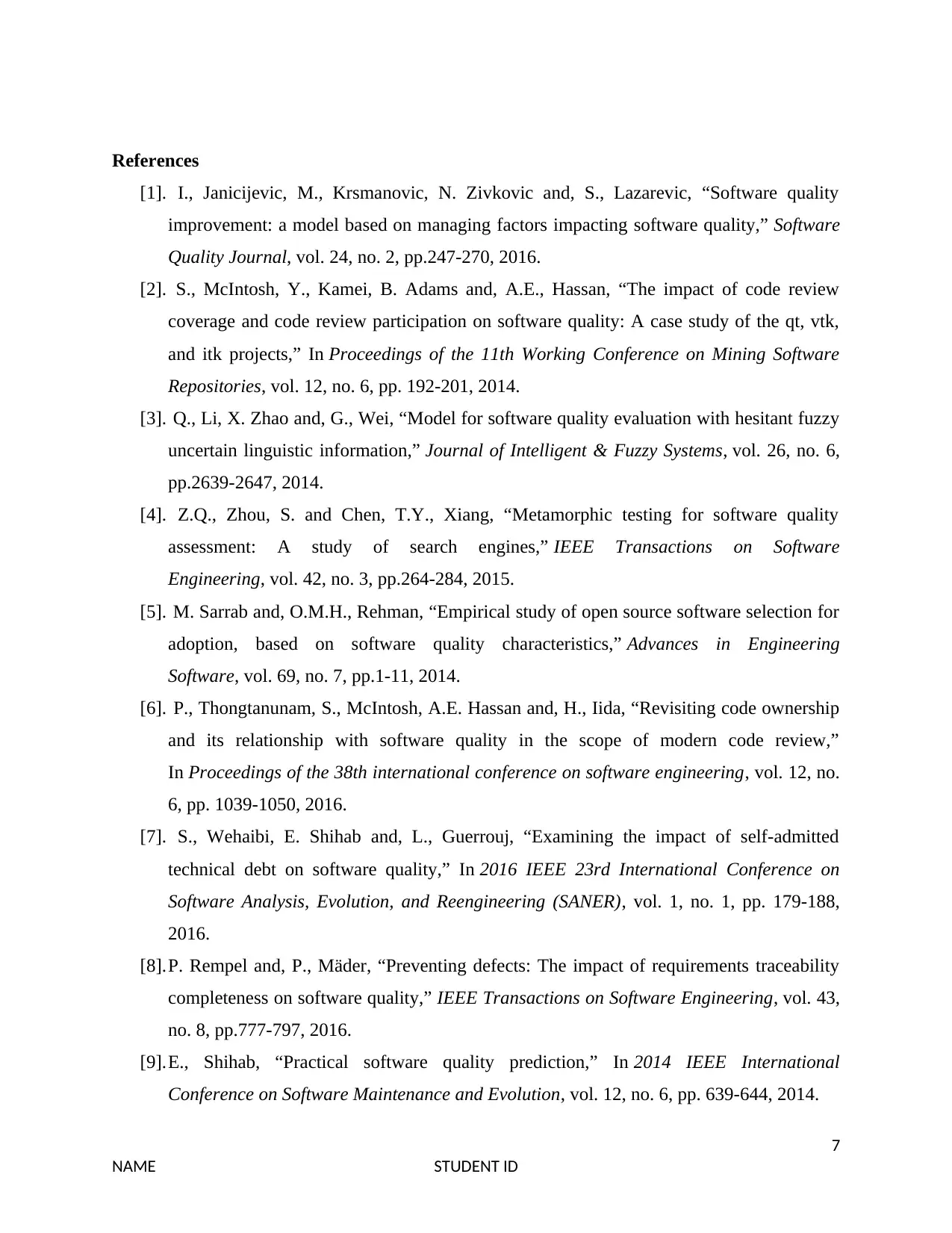
References
[1]. I., Janicijevic, M., Krsmanovic, N. Zivkovic and, S., Lazarevic, “Software quality
improvement: a model based on managing factors impacting software quality,” Software
Quality Journal, vol. 24, no. 2, pp.247-270, 2016.
[2]. S., McIntosh, Y., Kamei, B. Adams and, A.E., Hassan, “The impact of code review
coverage and code review participation on software quality: A case study of the qt, vtk,
and itk projects,” In Proceedings of the 11th Working Conference on Mining Software
Repositories, vol. 12, no. 6, pp. 192-201, 2014.
[3]. Q., Li, X. Zhao and, G., Wei, “Model for software quality evaluation with hesitant fuzzy
uncertain linguistic information,” Journal of Intelligent & Fuzzy Systems, vol. 26, no. 6,
pp.2639-2647, 2014.
[4]. Z.Q., Zhou, S. and Chen, T.Y., Xiang, “Metamorphic testing for software quality
assessment: A study of search engines,” IEEE Transactions on Software
Engineering, vol. 42, no. 3, pp.264-284, 2015.
[5]. M. Sarrab and, O.M.H., Rehman, “Empirical study of open source software selection for
adoption, based on software quality characteristics,” Advances in Engineering
Software, vol. 69, no. 7, pp.1-11, 2014.
[6]. P., Thongtanunam, S., McIntosh, A.E. Hassan and, H., Iida, “Revisiting code ownership
and its relationship with software quality in the scope of modern code review,”
In Proceedings of the 38th international conference on software engineering, vol. 12, no.
6, pp. 1039-1050, 2016.
[7]. S., Wehaibi, E. Shihab and, L., Guerrouj, “Examining the impact of self-admitted
technical debt on software quality,” In 2016 IEEE 23rd International Conference on
Software Analysis, Evolution, and Reengineering (SANER), vol. 1, no. 1, pp. 179-188,
2016.
[8].P. Rempel and, P., Mäder, “Preventing defects: The impact of requirements traceability
completeness on software quality,” IEEE Transactions on Software Engineering, vol. 43,
no. 8, pp.777-797, 2016.
[9].E., Shihab, “Practical software quality prediction,” In 2014 IEEE International
Conference on Software Maintenance and Evolution, vol. 12, no. 6, pp. 639-644, 2014.
7
NAME STUDENT ID
[1]. I., Janicijevic, M., Krsmanovic, N. Zivkovic and, S., Lazarevic, “Software quality
improvement: a model based on managing factors impacting software quality,” Software
Quality Journal, vol. 24, no. 2, pp.247-270, 2016.
[2]. S., McIntosh, Y., Kamei, B. Adams and, A.E., Hassan, “The impact of code review
coverage and code review participation on software quality: A case study of the qt, vtk,
and itk projects,” In Proceedings of the 11th Working Conference on Mining Software
Repositories, vol. 12, no. 6, pp. 192-201, 2014.
[3]. Q., Li, X. Zhao and, G., Wei, “Model for software quality evaluation with hesitant fuzzy
uncertain linguistic information,” Journal of Intelligent & Fuzzy Systems, vol. 26, no. 6,
pp.2639-2647, 2014.
[4]. Z.Q., Zhou, S. and Chen, T.Y., Xiang, “Metamorphic testing for software quality
assessment: A study of search engines,” IEEE Transactions on Software
Engineering, vol. 42, no. 3, pp.264-284, 2015.
[5]. M. Sarrab and, O.M.H., Rehman, “Empirical study of open source software selection for
adoption, based on software quality characteristics,” Advances in Engineering
Software, vol. 69, no. 7, pp.1-11, 2014.
[6]. P., Thongtanunam, S., McIntosh, A.E. Hassan and, H., Iida, “Revisiting code ownership
and its relationship with software quality in the scope of modern code review,”
In Proceedings of the 38th international conference on software engineering, vol. 12, no.
6, pp. 1039-1050, 2016.
[7]. S., Wehaibi, E. Shihab and, L., Guerrouj, “Examining the impact of self-admitted
technical debt on software quality,” In 2016 IEEE 23rd International Conference on
Software Analysis, Evolution, and Reengineering (SANER), vol. 1, no. 1, pp. 179-188,
2016.
[8].P. Rempel and, P., Mäder, “Preventing defects: The impact of requirements traceability
completeness on software quality,” IEEE Transactions on Software Engineering, vol. 43,
no. 8, pp.777-797, 2016.
[9].E., Shihab, “Practical software quality prediction,” In 2014 IEEE International
Conference on Software Maintenance and Evolution, vol. 12, no. 6, pp. 639-644, 2014.
7
NAME STUDENT ID
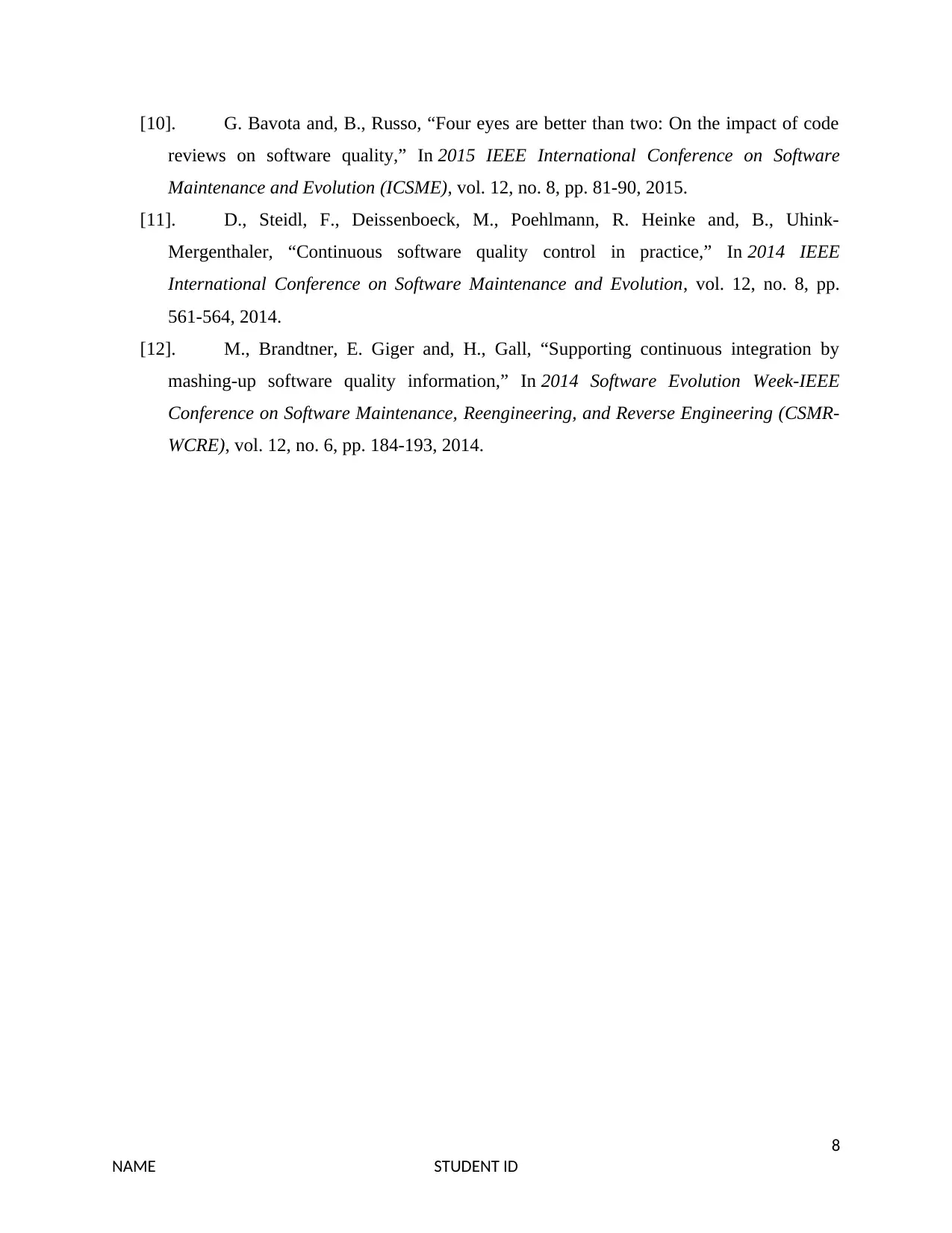
[10]. G. Bavota and, B., Russo, “Four eyes are better than two: On the impact of code
reviews on software quality,” In 2015 IEEE International Conference on Software
Maintenance and Evolution (ICSME), vol. 12, no. 8, pp. 81-90, 2015.
[11]. D., Steidl, F., Deissenboeck, M., Poehlmann, R. Heinke and, B., Uhink-
Mergenthaler, “Continuous software quality control in practice,” In 2014 IEEE
International Conference on Software Maintenance and Evolution, vol. 12, no. 8, pp.
561-564, 2014.
[12]. M., Brandtner, E. Giger and, H., Gall, “Supporting continuous integration by
mashing-up software quality information,” In 2014 Software Evolution Week-IEEE
Conference on Software Maintenance, Reengineering, and Reverse Engineering (CSMR-
WCRE), vol. 12, no. 6, pp. 184-193, 2014.
8
NAME STUDENT ID
reviews on software quality,” In 2015 IEEE International Conference on Software
Maintenance and Evolution (ICSME), vol. 12, no. 8, pp. 81-90, 2015.
[11]. D., Steidl, F., Deissenboeck, M., Poehlmann, R. Heinke and, B., Uhink-
Mergenthaler, “Continuous software quality control in practice,” In 2014 IEEE
International Conference on Software Maintenance and Evolution, vol. 12, no. 8, pp.
561-564, 2014.
[12]. M., Brandtner, E. Giger and, H., Gall, “Supporting continuous integration by
mashing-up software quality information,” In 2014 Software Evolution Week-IEEE
Conference on Software Maintenance, Reengineering, and Reverse Engineering (CSMR-
WCRE), vol. 12, no. 6, pp. 184-193, 2014.
8
NAME STUDENT ID
⊘ This is a preview!⊘
Do you want full access?
Subscribe today to unlock all pages.

Trusted by 1+ million students worldwide
1 out of 9
Related Documents
Your All-in-One AI-Powered Toolkit for Academic Success.
+13062052269
info@desklib.com
Available 24*7 on WhatsApp / Email
![[object Object]](/_next/static/media/star-bottom.7253800d.svg)
Unlock your academic potential
Copyright © 2020–2025 A2Z Services. All Rights Reserved. Developed and managed by ZUCOL.





